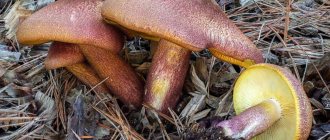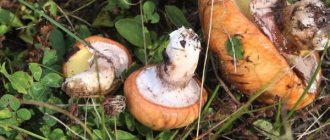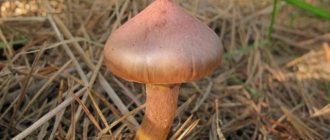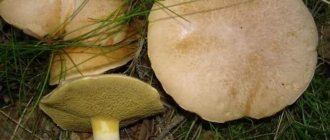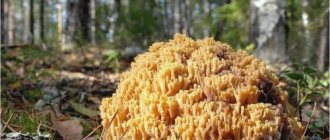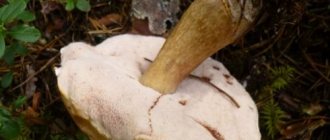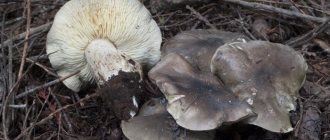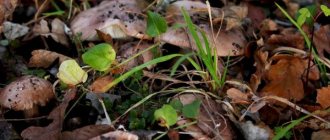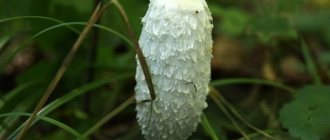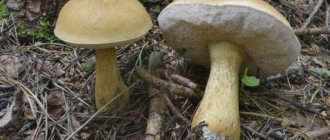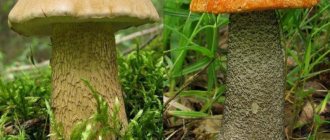Description of appearance
Rogatik pistil is a fairly large conditionally edible mushroom of light yellow color with a characteristic elongated shape.
Fruiting body
Pistil horn.
As such, the cap is not expressed - the fruiting body is not divided into component parts, but represents a single formation. It reaches a height of 10-15, sometimes 25-30 cm.
The shape resembles a cylinder, and at the bottom edge it begins to taper, so sometimes it looks like a large pin. It is painted in light yellow pastel colors, but with age it begins to darken and becomes first bright yellow, then orange.
If you touch the flesh, it may turn red and take on wine tones.
The horn is club-shaped.
At the same time, young mushrooms have a pleasant, smooth surface, and then grooves begin to form along the fruiting body.
The flesh of the horntail compresses well, like a sponge. When cut, it has light shades and begins to darken quite quickly. There is no special aroma.
Spore powder
The spores are round, may be oval. The powder is white or sometimes light yellow.
Benefits of edible cattails
Very often they are called coral, since in appearance they are very similar to them. Compared to others, they have a number of advantages:
- when fully ripe, the weight is almost one kilogram, which easily allows you to feed all family members;
- are not affected by worms, so when cleaning you will not encounter unpleasant disappointment;
- have a fragrant smell (but not old ones);
- there are no poisonous imitators;
- easy to prepare.
Due to their specific appearance, you are unlikely to confuse them with other plants.
Distribution and collection
The fungus most often grows in large colonies, sometimes found alone. It loves warm, humid deciduous forests, so it is most often found in the southern regions. It forms mycorrhizae with various trees, mainly with beech.
Pistil horn.
The fruits begin to appear in August, they also grow throughout September. If the autumn is quite warm, the cattail can be found in the first half of October.
Botanical characteristics
It is a close relative of chanterelles. It differs from other genera in the kingdom of mushrooms in the special structure of the fruiting body, which in most varieties has a highly branched structure with a clearly defined mushroom stalk.
- Fruiting body: according to its appearance, it is conventionally divided into groups (coral-shaped branched, club-shaped and awl-shaped). The structure of the branches is branched, divided into two parts, interconnected internally. This type of branching is called dichotomous. Both parts are almost equal in height, growing almost in a parallel direction. The color of the fruiting body varies: white, cream, pale yellow, brown or brown. When mechanically applied (pressure), it changes color to burgundy-red.
- Mushroom stem: depending on the type, the diameter of the mushroom stem can vary up to 1-2 cm, with a height of 6-25 cm. The color is pale yellow, some mushrooms have a purple tint. In many species, in the base area there is often a noticeable accumulation of mycelial hyphae or there are thread-like mycelial strands composed of parallel hyphae partially fused together in the longitudinal direction.
Edibility
According to the general classification, it is classified as inedible. The taste is bitter, peppery. Only a few varieties are conditionally edible and can be used for food purposes, but they have a low nutritional value class.
Area
The habitats cover the Eurasian continent and the North American continent. It grows everywhere in Russia, especially in the Far Eastern regions and European regions.
Among its habitats, it prefers coniferous and mixed forest belts, where pine and spruce trees predominate. It is more often found on rotting wood debris, less often growing on the surface of the ground in the bush area.
Similar species
There are no poisonous mushrooms similar to this species.
However, representatives of the same family are similar to it:
- Horntail truncated.
It differs in that the upper part of the body is flat rather than round, i.e. looks a bit like a real hat.
- Rogatik fusiform.
This mushroom is distinguished by a completely cylindrical fruiting body, and it is colored in rich yellow shades. If you press on the pulp, its color will not change, unlike Rogatik pistil.
1- Horntail truncated. 2- Rogatik fusiform.
Edibility of mushrooms
Very often in the forests you can meet mushroom pickers who claim that they know everything about mushrooms. But what can they say about the slingshots? In order not to accidentally get poisoned and to know for sure whether this mushroom is edible or not, we have prepared a small cheat sheet.
| Variety | Can I eat or not? |
| Fusiform | No |
| Comb | No |
| Dudchaty | No |
| Pale yellow | No |
| Pistillate | No |
| Straight | No |
| Purple | No |
| Amethyst | Yes |
| bunch-shaped | Yes |
| Yellow | Yes |
| Golden | Yes |
| Truncated | Yes |
| Reed | Yes |
Interesting Facts
Clavariadelphus pistillaris.
- Many sources indicate that the pistillate mushroom is an inedible mushroom, since its pulp is noticeably bitter. In fact, it is edible, but more often it is either not consumed at all or used in combination with other mushrooms. First, it must be thoroughly rinsed and soaked in cold water for several hours.
- Despite the lack of interest on the part of mushroom pickers, the horned pistil is already listed in the Red Books of many countries, including 39 regions of Russia, as well as in the book of Ukraine, Wales and Macedonia. The reason is that recently there has been a significant reduction in beech forests, and the mushrooms themselves are dying along with the trees.
Application
Representatives of the Ramaria family are used in cooking and medicine. They make delicious first and second courses. Traditional healers have long collected these mushrooms for tinctures that help against gastrointestinal diseases.
In medicine
Deer horns are a natural antibiotic. They contain:
- hydroxytryptophan;
- melatonin;
- serotonin.
Horntail extract helps to defeat Crocker's sarcomas and Ehrlich's ascitic carcinomas.
In cooking
Bagels with mushrooms are not the only treat that can be prepared from ramaria. For example, yellow forest corals are suitable for soups, and reed corals are fried, stewed or made into caviar.
Preparing horned mushrooms is not difficult; to do this, you need to soak the mushroom crop in salted water and lightly boil it. Horn mushrooms are dried and frozen for the winter. To feel the subtle aroma of the product, a minimum of spices and seasonings are added to the dish.
Rogatik is a little-studied mushroom that many lovers of quiet hunting do not pay attention to. There are no poisonous specimens among the representatives of this family, but it is recommended to collect and eat ramaria with caution.
Precautionary measures
There are many plants that look like deer legs. Many of them are quite poisonous. Therefore, if you are new to this business, then ask an experienced mushroom picker to tell and show how to correctly collect and distinguish deer legs from other plants.
Remember that after harvesting, before cooking, you must rinse and process them well, because if not prepared correctly, they can have serious negative effects on your body.
Do not harvest near highways, as plants quickly absorb toxic substances.
foodandhealth.ru
Can it be eaten?
The pistillate hornet is in principle edible. The bitter taste of the pulp is eliminated by preliminary boiling. At the same time, this is a rare species legally protected in Russia, so it should not be made an object of mushroom fishing.
Pistil horntail is rarely found by domestic mushroom pickers. If such a meeting occurs, it is better not to put it in the basket, but to report the location of the find to the environmental inspection, which will register and take into account the new distribution sector of this rare variety of clavariadelphus.
How to clean deer antlers. Fried reindeer horns – recipe with photo
Deer horn mushrooms not only look unusual, but also have an incredibly rich taste. And if you fry them and serve them, for example, with mashed potatoes, then they will deserve the highest score!
The mushrooms, which bear the unusual name “deer horns,” are also known as coral mushrooms or horn mushrooms. They are collected in summer or early autumn. You can find specimens in a variety of shades - from almost white, light beige to rich yellow or even bright orange. The darker and brighter the mushroom, the older it is, so when choosing or collecting deer antlers, give preference to lighter bunches. Fried deer horns are very tender, aromatic and incredibly tasty.
How to fry reindeer horns - step-by-step preparation of mushrooms
Prepare the mushrooms. Go through them, remove any debris, rinse the horns under running water and cut off the dirty ends from the legs, if necessary. If the mushrooms are very dirty, soak them in water for 15 minutes and then drain well.
Peel the onion and cut into slices or half rings. Start frying the onions in a small amount of vegetable oil. It is better to take refined one so that its smell does not overwhelm the aroma of mushrooms.
Once the onions are browned, add the chopped coral mushrooms to the pan.
Fry the deer horns for 15–20 minutes, stirring from time to time so that they fry evenly.
And now a simple but extremely tasty dish - fried reindeer horns - is ready! All that remains is to boil the potatoes and serve them whole with the mushrooms or make mashed potatoes from them.
Don't be afraid to experiment and you will be rewarded! At first glance, a rather inconspicuous product can turn into a very appetizing dish, an example of this statement is fried deer horns. Bon appetit!
False doubles
Truncated cattails resemble the species described. They are distinguished by a flat top of the fruiting body and a more pleasant, sweet taste. They grow in coniferous forests. They are rare in Eurasia; they are more often found in North America. They are classified as conditionally edible.
Another edible look-alike is the horned hornet or Clavariadelphus ligula. This is a small mushroom, up to 10 cm high. It has an elongated club-shaped shape with a rounded or spade-shaped tip. Young specimens are smooth, later they acquire longitudinal folds, and the cream color turns into orange-yellow. This species is more common than the club-shaped horntail, but also has low nutritional value and is used as food after boiling.
Taxonomy
Synonyms
- Clavaria alba Pers., 1822, nom. superfl.
- Clavaria coralloides L., 1753basionym
- Clavaria coralloides var. alba Bull., 1791
- Clavaria coralloides var. elegans (Bolton) Purton, 1821
- Clavaria coralloides var. lappa P.Karst., 1882
- Clavaria coralloides var. lutea Bull., 1791
- Clavaria coralloides-cinerea Bull. 1788, no. inval.
- Clavaria cristata (Holmsk.) Pers., 1801
- Clavaria cristata var. ambigua Pass., 1885
- Clavaria cristata var. cinerascens Sacc., 1879
- Clavaria cristata var. curta Jungh., 1830
- Clavaria cristata var. fallax Fr., 1821
- Clavaria cristata var. fimbriata (Pers.) Fr., 1821
- Clavaria cristata var. flexuosa Jungh., 1830
- Clavaria cristata var. minor Pat., 1884
- Clavaria cristata var. nivea Pers., 1801
- Clavaria cristata var. vulgaris Alb. & Schwein., 1805
- Clavaria elegans Bolton, 1790
- Clavaria fimbriata Pers., 1794
- Clavaria holmskjoldiana Fr., 1818
- Clavaria rugosa var. elegans (Bolton) Pers., 1801
- Clavulina cristata (Holmsk.) J.Schröt., 1888
- Clavulina cristata f. bicolor Donk, 1933
- Clavulina cristata f. subcinerea Donk, 1933
- Clavulina cristata subsp. cinerascens Corner, 1950
- Clavulina cristata subsp. coralloides (L.) Corner, 1950
- Clavulina cristata subsp. eucristata Corner, 1950, nom. superfl.
- Clavulina cristata var. bicolor (Donk) Cetto, 1987
- Clavulina cristata var. brunneola KSThind & Anand, 1956
- Clavulina cristata var. incarnata Corner, 1950
- Clavulina cristata var. lappa P.Karst., 1882
- Clavulina cristata var. subrugosa Corner, 1950
- Clavulina cristata var. zealandica RHPetersen, 1988
- Clavulina incarnata (Corner) Olariaga, 2013
- Ramaria alba (Bull.) Quél., 1894
- Ramaria coralloides (L.) Holmsk., 1790
- Ramaria cristata Holmsk., 1790
- Stichoramaria cristata (Holmsk.) Ulbr., 1928
